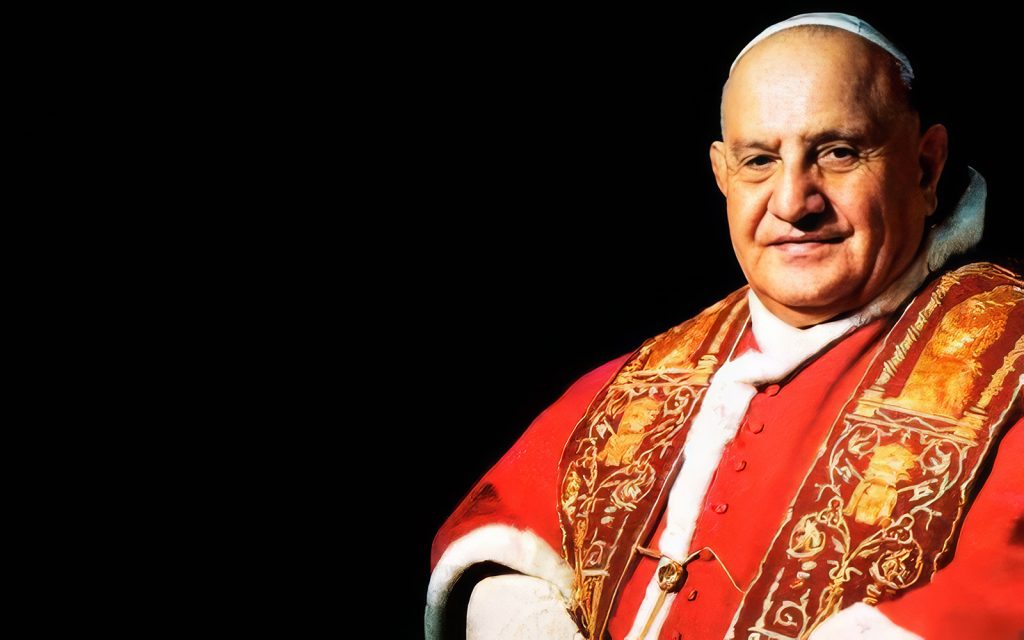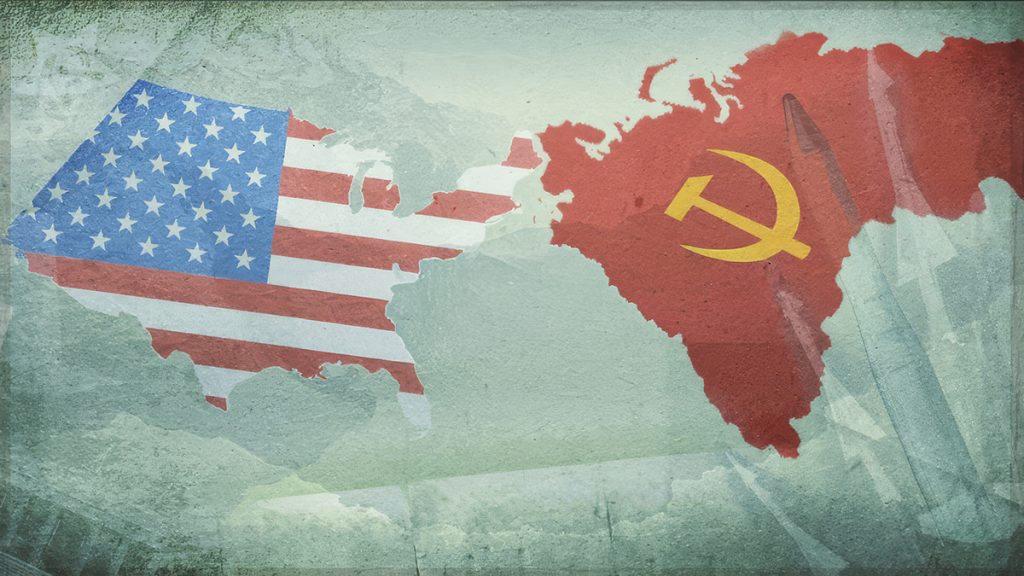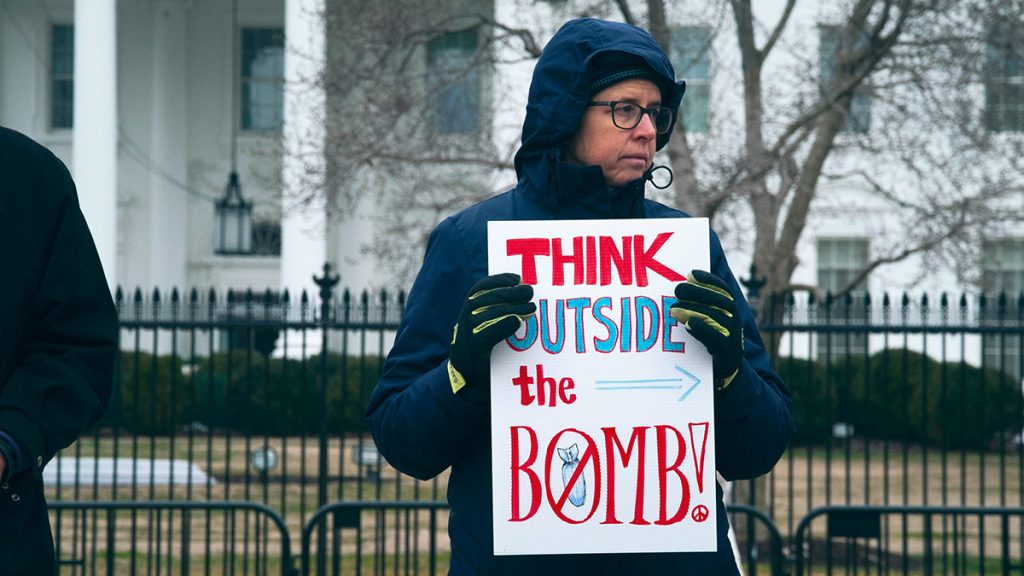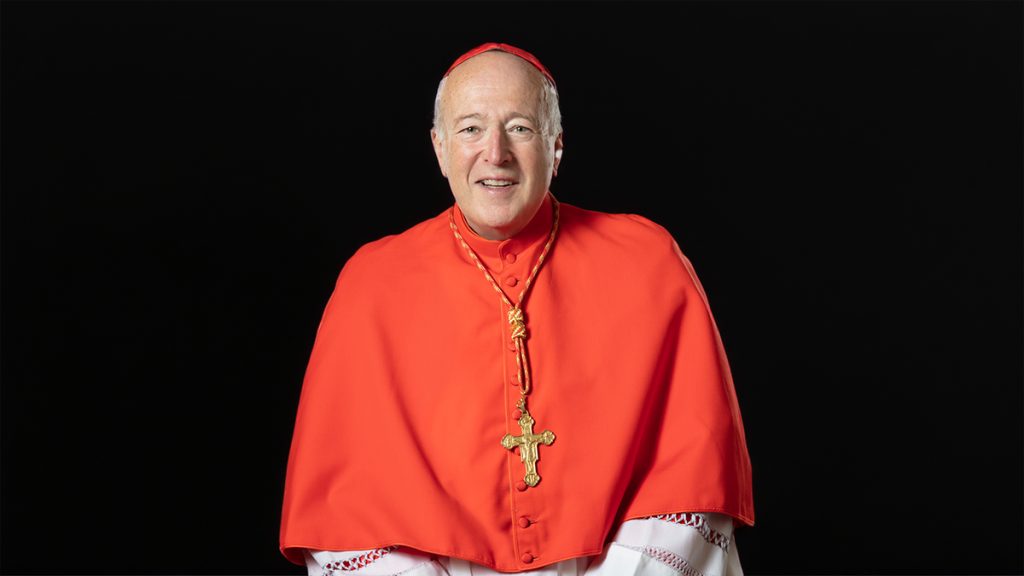This year (2023) marks the sixtieth anniversary of Pacem in Terris and the fortieth anniversary of The Challenge of Peace, the American bishops’ pastoral letter on questions of war and peace.
It is hard to overestimate the impact of Pacem in Terris within both the Catholic community and the international community as a whole.
Written in the shadow of the Cuban Missile Crisis, it arose from a conviction that the church must speak forcefully to the question of peace from its rich tradition, but must also do so with a profound attention to the signs of the times.

Pope John set forth a comprehensive framework for building authentic peace in the world by outlining the fundamental human rights that alone can generate a lasting peace, as well as providing a profound reflection upon the implications of the international community that was emerging in the 1960’s.
“In this age of ours,
Pope John XXIII
which prides itself
on its atomic power,
it is irrational to think
that war is a proper way
to obtain justice
for violated rights.”
Finally, Pope John placed the threat of nuclear weapons vividly in front of the world and proclaimed, “in this age of ours, which prides itself on its atomic power, it is irrational to think that war is a proper way to obtain justice for violated rights.”
Twenty years after the issuance of Pacem in Terris, the Catholic bishops of the United States took up the daunting task of applying the teachings of the Vatican Council, as well as those of Pope John, Pope Paul VI and Pope John Paul II, to the deeply polarized debate on war and nuclear weapons in America.
Their resulting pastoral letter: The Challenge of Peace: God’s Promise and Our Response, was a penetrating and comprehensive catechesis for the Catholic community and a witness of faith and wisdom for American society as a whole.
Shared vision of peace and justice
The Challenge of Peace set forth the substantive conception of peace that arises from the Scriptures and the tradition of human reason – the same conception of peace rooted in justice and human rights that had been the foundation for Pacem in Terris.
It presented both the tradition of non-violence and the legitimate use of military means to defend human rights as authentic expressions of Catholic faith designed to attain the same goal: the comprehensive protection of humanity under attack.
And the pastoral letter consistently presented defensive war as a last resort throughout its analysis of the challenges which the world was facing.
Perhaps most importantly of all, The Challenge of Peace addressed the crisis of nuclear confrontation between the United States and the Soviet Union, as well as the wider questions of nuclear proliferation.
The bishops proclaimed that the combination of nuclear threats and the prevalence of conventional war in the world using highly advanced weapons systems had created a “New Moment” that demanded the specific application of Catholic teaching on war and peace to particular policy questions.
For this reason, The Challenge of Peace dealt in detail with the issues of counter population nuclear war, the initiation of nuclear war, the concept of limited nuclear war and the pathways to reversing nuclear proliferation.
This bishops’ statement deeply informed public policy, educated millions of Catholics about the Church’s teaching on war and peace, and provided an enduring example of how bishops can teach effectively on volatile questions in a polarized environment.
Our new moment
Forty years have passed since The Challenge of Peace.
To put that in perspective, that is a longer period than that between the dropping of the atomic bombs on Japan and the issuance of the bishops’ pastoral letter.
As the bishops of the United States understood, the changes in the nature of warfare and the international community had created a new moment in 1983 that demanded a renewed understanding and application of Catholic teaching on war and peace amidst changed circumstances.
The Church
Cardinal McElroy
must engage with the world
in this moment
in order to contribute
the perspective
of Catholic faith and tradition in a perilous age.
With the passage of these forty years, we too, stand in a new moment.
As a consequence, three major shifts in Catholic thinking are taking place.
The continuation of wars among nations and within societies, enlisting devastating weapons and resulting in countless deaths have pointed to the need to fundamentally renew and prioritize the claim of non-violent action as the central tenet of Catholic teaching on war and peace.
The atrophying of the just war framework as an effective constraint on war or pathway to peace calls the Church to redesign its moral framework for permitting war in dire circumstances.
And the failure of nuclear deterrence as a “step on the way to nuclear disarmament” has produced a situation where we are facing the breakdown of the arms control regime and the possibility of the use of tactical nuclear weapons.
The Church must engage with the world in this moment in order to contribute the perspective of Catholic faith and tradition in a perilous age.
And the Church in the United States must grapple with these foundational questions if we are to be faithful to our lives as citizens and believers.
The centrality of an ethic of non-violence
Ever since Pacem in Terris was written, every successive Pope has pointed to the moral depravity of war.
Pope John proclaimed that “it is hardly possible to imagine that in an atomic era, war could be used as an instrument of justice.”
Pope Paul VI journeyed to the United Nations to plead with the world “No more war. War never again.”
Pope John Paul II taught that war is never an appropriate way to settle disputes among peoples: “it has never been and it will never be.”
Joseph Ratzinger chose the name Benedict to tie his entire pontificate to that of Pope Benedict XV, who tried to end all war.
But it is Pope Francis who has utilized the trajectory of all of these statements to construct a framework for Catholic teaching on war and peace that places non-violence rather than the just war-ethic as the dominant prism through which to evaluate decisions in situations of deep conflict.
“War is a failure of politics
— Pope Francis
and of humanity,
a shameful capitulation,
a stinging defeat
before the forces of evil.”
In Fratelli Tutti he writes: “We can no longer think of war as a solution, because its risks will probably always be greater than its supposed benefits. In view of this, it is very difficult nowadays to invoke the rational criteria elaborated in earlier centuries to speak of the possibility of a just war. Never again war.”
Francis is even clearer in his elaboration on the horrific nature of war as it has emerged in our times:
“Every war leaves our world worse that it was before. War is a failure of politics and of humanity, a shameful capitulation, a stinging defeat before the forces of evil. Let us not remain mired in theoretical discussions, but touch the wounded flesh of the victims. Let us look once more to those civilians whose killing was considered collateral damage. Let us ask the victims themselves. Let us think of the refugees and the displaced, those who suffered the effects of atomic radiation or chemical attacks, the mothers who lost their children, and the boys and girls maimed or deprived of their childhood. In this way we will be able to grasp the abyss of evil at the heart of war. Nor will it trouble us to be deemed naive for choosing peace.”
The charge of naivete traditionally leveled against advocates of non-violence has been gravely diminished in its legitimacy in recent years through a series of studies of real-world conflicts.
Non-violent resistance
Cardinal McElroy
can often be
significantly more effective
than armed defense
in achieving
the sustainable vindication
of human rights.
Erica Chenoweth and Maria Stephan’s book Why Civil Resistance Works, used quantitative analysis from a wide variety of conflicts within and among nations. Some ended in armed conflict, others did not.
But their demonstration that non-violent resistance can often be significantly more effective than armed defense in achieving the sustainable vindication of human rights in the forms of conflict that have emerged as the dominant military confrontations of our day lends tremendous strength to the proposition that the Church should place non-violent resistance at the center of its theology of war and peace.
If one were asked in 1983 to state what framework stood as the central point of reference for the Church on armed conflict, they would have correctly answered: the just war theory.

If we are asked today to answer that question, we must answer: comprehensive non-violence.
Extreme cases
Even in recognizing the Gospel exhortations to reject warfare in all of its forms, and even in recognizing the manifest frequent superiority of outcomes through non-violent resistance, there are instances which call out for military action against profoundly barbaric aggression.
We are witnessing just such a moment in Ukraine.
While one can criticize Ukraine and the West for not adequately seeking continuous de-escalation in their tensions with Russia in recent years, the moral claim for the defense of Ukraine is clear and compelling.
A sovereign nation with a historic culture and identity were invaded with the goal of dismembering their homeland.
Thus, the fundamental moral justification for military action is unassailable.
But does the Church have an ethic which is able in the present day navigate the moral choices that Ukraine and its allies must make in repelling the Russian invasion?

The just war tradition would typically occupy this space in Catholic thinking.
And certainly some elements of that tradition – the prohibition of direct attacks upon civilians and the principal of proportionality for all military actions – are as effective in their moral witness and moral realism as they have ever been.
But the overarching strategic framework of the just war tradition – the ius ad bellum – has become hobbled in its ability to provide effective comprehensive guidance in the modern day.
One problem, of course, is that for so many recent uses of the tradition to evaluate a decision for military action, the just war framework has operated as a source of justification for those inclined to go to war rather than as a constraint on war.
One accelerant for this trend was the unfortunate statement in the Catechism that the evaluation of the just war criteria belongs to those who have responsibility for the common good.
It is objective moral reality which determines whether the ius ad bellum has been met, not the views of political leaders.
But there are far wider reasons which make the just war tradition inadequate for decision-making in situations like Ukraine.
The tradition is weak in two crucial areas of moral choice.
The first is the moral requirement to actively and strenuously seek peace, even if it means making significant concessions.
Warfare expands war aims rather than reducing them.
The just war tradition does not include a realistic set of moral criteria for seeking war termination.
The general principles of right intention and proportionality are not focused enough to provide effective guidance in this area.
If the war in Ukraine falls into protracted stalemate, this deficiency will become even clearer.
Another major deficiency in the just war framework is its lack of attention to the moral obligations of other nations in minimizing a military conflict.
Catholic theology has pointed unswervingly for the past century to the reality that an international society exists, and that a set of military, economic and political obligations flow from that reality.
So many of the wars we have witnessed in recent decades have effectively constituted surrogate wars of greater powers.
We are now in a situation where a small nation is fighting heroically to defend itself, while the surrounding major military and economic powers supply enough weaponry and economic support to sustain the Ukrainians but not so much that it might trigger catastrophic action by Russia.
This is a moral minefield for which the just war tradition cannot provide a map.
The central moral question that Ukraine raises touches upon the moral responsibilities of third parties in the conflict, which will probably determine the outcome of the war.
The new moment in which we are living demands a deep renewal, restructuring and expansion of the Catholic teaching on the legitimacy of war in extremis.
There are ethical tools for this in Catholic teaching, but they must be forged into a larger contemporary ethic of war so that the ethics of war termination and the moral obligations of all participants are clearer during ongoing conflicts.

The specter of nuclear weapons
A final element of the new moment for Catholic teaching on war and peace in which we stand concerns the moral liceity of possessing nuclear weapons.
The relationship of the imperative to eliminate nuclear weapons and the realities of deterrence have framed Catholic teaching for the past sixty years.
Consistently, the Church has demanded that nuclear weapons be removed from the face of the earth.
This element of Catholic doctrine has never changed.
But the treatment of deterrence – and how it conditions the moral imperative to eliminate nuclear weapons – has shifted dramatically since the issuance of Pacem in Terris.
Pope John was less troubled by the reality of deterrence itself than by the risks which nuclear testing would bring:
“Even though the monstrous power of modern weapons does indeed act as a deterrent, there is reason to fear that the very testing of nuclear devices for war purposes can, if continued, lead to serious danger for various forms of life on earth.”
By 1982 Pope John Paul II was emphasizing the temporary nature of the moral legitimation of the possession of nuclear weapons for deterrent purposes:
“…the logic of nuclear deterrence cannot be considered a final goal or an appropriate and secure means for safeguarding international peace.”
For this reason, The Challenge of Peace labeled nuclear deterrence as “a step on the way toward progressive disarmament.”
Pope Francis views nuclear deterrence not as a source of peace, but a destabilizing element in the international system that creates a false sense of security, encourages the proliferation of nuclear weapons, threatens the environment and robs from the poor.
Pope Francis
Cardinal McElroy
categorically condemned
the possession
of nuclear weapons
as morally illicit.
As a consequence, at a conference at the Vatican following the passage of the international Treaty on the Prohibition of Nuclear Weapons, Pope Francis categorically condemned the possession of nuclear weapons as morally illicit.
Discerning the implications of this dramatic shift in Catholic teaching constitutes one of the central tasks for theologians, bishops, policymakers and committed Catholics who work in the area of ethics and nuclear weapons.
On this issue the successive moral positions of the Church regarding deterrence and possession have all been consciously framed as interim ethics in anticipation of a better moment.
How can we realistically contribute in God’s grace to bringing that moment to reality?

Toward a nuclear-free world
Drew Christiansen and Carole Sargent’s splendid book Forbidden: Receiving Pope Francis’ Condemnation of Nuclear Weapons, points powerfully to the comprehensive moral discernment and action which can forge within the Catholic community a realistic yet passionate framework capable of creating, sustaining and expanding a coherent pathway to advance the consistent Magisterial call to eliminate nuclear weapons.
By focusing on the variety of communities which will be necessary to build a nuclear free world, the Catholic Peacebuilding Network in which Dr. Powers has taken such an active role, has given hope and realism for all those who seek to realize the Catholic vision of peace.
Archbishop John Wester of Santa Fe has provided a complementary pathway to advance a nuclear free world.
Rooted in a profoundly spiritual conviction that nuclear arms simply must be eliminated, he has begun wide conversations in the ecclesial and public policy communities in the very state where the bomb was born and where nuclear technology is vital to the state economy.
Archbishop Wester’s conviction was ignited in Hiroshima, and it shares the same unswerving drive that characterized Saint John Paul II’s statement at Hiroshima:
“Our future on this planet, exposed as it is to nuclear annihilation, depends on one single factor: the world must make an about face. May we all be part of initiating that about face.”

- Cardinal Robert W. McElroy “Our New Moment: Renewing Catholic Teaching on War and Peace,” The Journal of Social Encounters: Vol. 7: Iss. 1, 266-271. Republished with permission.
- When written in 2023, Cardinal McElroy was bishop of Diocese of San Diego, California. He is now the dioces of Archbishop of Washington DC.
- Cardinal McElroy received his Ph.D. in Political Science from Stanford University in 1989 with a dissertation on Morality and American Foreign Policy: The Role of Moral Norms in International Affairs. He is author of The Search for an American Public Theology: The Contributions of John Courtney Murray (Paulist Press, 1989), Morality and American Foreign Policy: The Role of Ethics in International Affairs (Princeton University Press, 1992), and articles on Catholic social thought.

